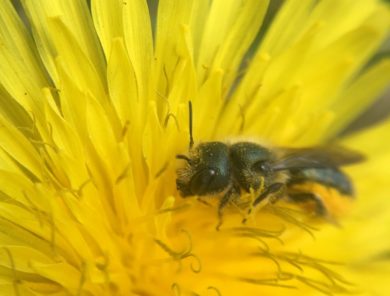
© Spencer Hardy
Uncommon to rare with in Vermont, this species is at the northern edge of its range here. It is a broad specialist on the family Asteracae (composites like dandelion and daisy). Currently known from Chittenden and Windsor County, this species should be looked for on dandelions in late May, at least in the warmer half of the state.
Identification: Females have a distinctive combination of knobs on the mandibles and yellow to whitish scopal hairs.
Females are 9 mm in length, males are 7.5 mm in length.
Similar Species: Texas Mason Bee (Osmia texana) is similar and closely related, but females are readily distinguished by the dark scopal hairs – a rare species closely tied to thistles.
Status:
Global Status: Secure.
More Information:
For more information on the Georgia Mason Bee, visit the following links:
Distribution
To see the global distribution, check out the iNaturalist account, and toggle the GBIF layer on the map.






